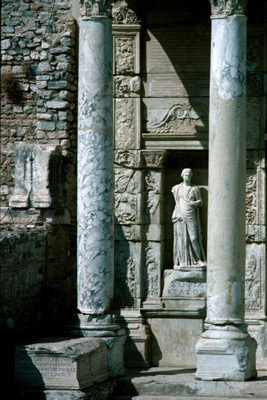In 92 A.D. , Tiberius Julius Celsus Polemaeanus was a consul in Rome, and was in charge of all public buildings. Between either 105-106 or 106-107 A.D. he was the proconsul (governor) of the Asian province, the capital of which was Ephesus, when he died in 114 A.D. at the age of seventy his son Tiberius Julius Aquila, built the library as a heron (mausoleum) for his father. It is assumed that the construction of the library was completed in 117.

The building is made of very good marble and decorated with figures of Eros, Nike, rosettes and garlands in relief . The building reflects the characteristics of the age of Emperor Hadrian. The facade is two-storied. On the lower storey, the columns with Corinthian capitals are placed on a 21 meters long podium reached by nine steps. The columns are arranged in pairs and between them there are three doors with richly decorated frames. The door in the middle is wider and taller than the other two.




Statues seen in the niches between the doors, are copies of the originals which were taken to Vienna during the years when the library was being excavated. As the inscriptions on the bases indicate, the statues symbolized the WISDOM (SOPHIA), KNOWLEDGE (EPISTEME), INTELLIGENCE ( ENNOIA) and VIRTUE (ARETE) of Celsus.
The interior of the library measures 10,92 by 16,72 meters and is covered with decorative marble. The section of the western wall above the tomb of Celsus is apsidal. It is agreed that the statue discovered during the excavations either to Celsus or to his son and it must have been located in this semi-circular niche. It is now exhibited in Istanbul Archaeological Museum. On the side walls, there are rows of niches where the scrolls were kept. The same type of niches is seen the upper sections of the walls too. The remains indicate that the interior of the library was not two-storied and that there was a balcony with railing in front of the niches, located where the second storey should have been.

In 262, during the Gothic attacks, the interior of the library was burnt completely but the facade was not affected much.